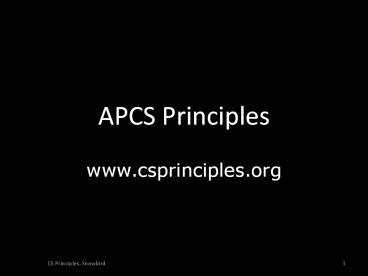APCS Principles - PowerPoint PPT Presentation
1 / 28
Title:
APCS Principles
Description:
APCS Principles www.csprinciples.org CS Principles, Snowbird * What? A new first course in computer science Alternative to CS1, not replacement Designed to be an AP ... – PowerPoint PPT presentation
Number of Views:90
Avg rating:3.0/5.0
Title: APCS Principles
1
APCS Principles
- www.csprinciples.org
2
What?
- A new first course in computer science
Collaborative CollegeBoard, NSF, Academia
(6-12/University)
Designed to be an AP course credit/placement
Alternative to CS1, not replacement
3
Process and Content
- How are we designing and building this course?
- Who is behind the development
- What is the process used
- What will be in this course?
- Content
- Skills
- Pedagogy
4
Toward another first course
- Harvard CS50, CS1
- Stanford CS 106A, CS 105
- Princeton COS 126, 116/109
- Berkeley CS61A, CS10
- Texas, CS 305J, CS 302
- Wisconsin, CS 302, CS 250/202
- Colorado CSCI 1300, 1220/1000
5
Toward another first course
- Tufts, Comp 11, Comp 9,7
- Clemson CPSC 101, CPSC 120
- USC, CS 101L, Nothing
- Virginia Tech, CS 1054, CS 1614
- U. Kansas, EECS 168, EECS 128
- Brown, CSCI 150, CSCI 20
- U. Mass, CMPSCI 121, CMPSCI 120
6
Who?
7
Who?
- Dan Garcia
- Joanna Goode
- Susanne Hambrusch
- Michelle Hutton
- Deepak Kumar
- Jim Kurose
- Andrea Lawrence
- Richard Pattis
- Katie Siek
- Beth Simon
- Larry Snyder
- Lynn Stein
- Fran Trees
- Lien Diaz
- Cameron Wilson
- Jan Cuny
- Kathy Haynie
- Don Allen
- Christine Alvarado
- Owen Astrachan
- Stacey Armstrong
- Tiffany Barnes
- Amy Briggs
- Charmaine Bentley
- Mark Guzdial
- Rich Kick
- Jody Paul
- Chris Stephenson
- Duane Bailey
- Gail Chapman
- Tom Cortina
- Stephen Edwards
8
Engineering a Course and Exam
9
Foundation of Course/Exam
- Commission convened to use College Board
framework and methodology to build course/exam - Evidence-centered design
- Claim student has knowledge or skill
- Evidence behavior/performance that the
skill/knowledge has been achieved - Drafted Seven Big Ideas
10
Commission and Advisory Board
- Commission has task of delivering framework for
course/exam using evidence centered design - Advisory board provides feedback, guidelines,
advice to commission - Advisory board actually advises
11
Timeline
- 2009-2010
- Big Ideas, Practices, Claims/Evidence
- 2010-11
- Pilot I Five colleges
- Draft College Survey
- Test item prototype
- 2011-12
- Pilot II 10 colleges, 10 high schools
12
Possible Next Timeline
- Necessary and sufficient conditions to continue
- How do we ensure substantial buy-in?
- 2012-2013
- Curricular framework finalized?
- Exam format identified
- Deploy exam and course
- 201?
- 2
13
From Process to Product
- What will be in this course?
- Pilot courses are exemplars
- Seven big ideas
- Six computational thinking practices
- 200 claims and evidence statements
- From bits to NP to modeling to
14
Wheres the Programming?
- To that end solving computational problems and
exploring creative endeavors, the course
highlights programming as one of the seven big
ideas of computer science, because programming is
among the creative processes that help transform
ideas into reality.
15
Big Ideas
- Computing is a creative human activity that
engenders innovation and promotes exploration. - Abstraction reduces information and detail to
focus on concepts relevant to understanding and
solving problems.
16
Big Ideas Continued
- Data and information facilitate the creation of
knowledge. - Algorithms are tools for developing and
expressing solutions to computational problems.
17
Big Ideas Continued
- Programming is a creative process that produces
computational artifacts. - Digital devices, systems, and the networks that
interconnect them enable and foster computational
approaches to solving problems.
18
Big Ideas
- Computing enables innovation in other fields
including science, social science, humanities,
arts, medicine, engineering, and business.
19
Computational Thinking Practices(Draft)
- Analyzing problems, artifacts, and effects of
computation - Creating and using computational artifacts,
computational models - Communicating processes and results
- Connecting computation with mathematics, science,
engineering - Work effectively in teams
20
Stories motivate computational examples
- What will students do? What problems will they
solve?
21
Undecidable, P/NP, heuristics
22
17 U.S.C. 512 DMCA
- Limitations on liability for service providers
- YouTube /Google v Viacom, June 23, 2010
- 24 hours video/minute
- Youtube 3/17/2010
- How many Gbytes?
- How does Youtube analyze audio tracks?
23
TinEye search
24
Thinking about TinEye and Testing
- Different images
- Size and format
- Clip image search
- Search? Success!
- Hide image search?
- Steganography
25
Steganography with 2 bits/pixel
26
Extract image from Hanoi 2 bits
27
Extracting image 2-bits
- def extractImage(im)
- newImage im.convert("RGB")
- data newImage.getdata()
- pic Image.new(im.mode,im.size,None)
- ndata (r464, g464, b464)
- for (r,g,b) in data
- pic.putdata(ndata)
- return pic
28
Future work
- Oversee pilot courses, analyze the outcomes of
the pilots, prepare for next, larger pilot - Gain consensus on claims and evidence (from 500
to 128) - Develop prototype exam questions
- Gather support for next phase of project































